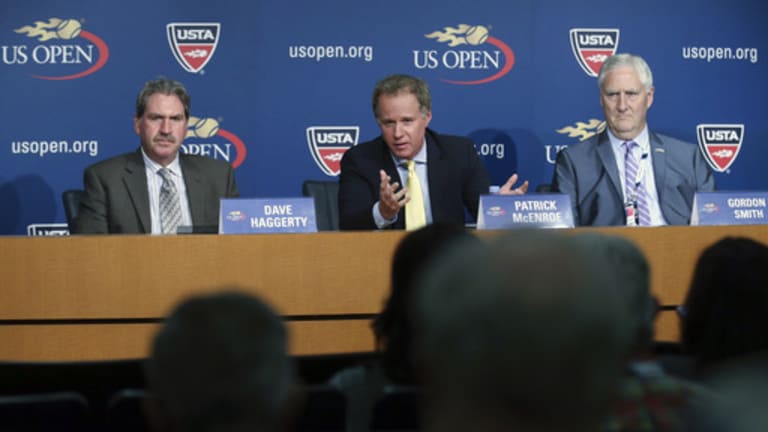“When I first went to Orlando two years ago, as we were looking potentially for sites just for player development . . . I wanted to do what I thought was right for the USTA and for tennis in the country.”—Patrick McEnroe, in the press conference announcing that he is stepping down as head of USTA Player Development.
NEW YORK—Let me start with the obligatory disclosure: I was McEnroe’s co-author on his recent book, Hardcourt Confidential: Tales from Twenty Years in the Pro Trenches. We’re friends, to as much of a degree as our professionally-rooted relationship allows.
Now let me give my take on his decision. In his opening remarks, McEnroe related how he and the other decision makers (most prominently, Gordon Smith, the USTA Executive Director and COO, and David Haggerty, the current USTA Chairman of the Board and President) all felt that the head of the Player Development program would have to be based in the new, 100-court facility that the USTA is building in the Lake Nona area of Orlando. The facility will become the epicenter of the U.S. player development effort.
McEnroe explained that, as the discussions about the new site evolved, the men looked each other and came to a realization: “The person (in command in Orlando) probably wasn't going to be me for a variety of reasons, both professional and personal.”
The professional reasons are somewhat obvious, and they occasionally generated criticism of McEnroe. For a lengthy period, he juggled three careers—one as a lead tennis commentator at ESPN, one as U.S. Davis Cup captain (for a full decade, ending in 2010) and one as head of USTA Player Development (beginning in 2008).
Complaints that McEnroe was doing a “part-time” job as head of development were counterbalanced by the fact that there really was no well-defined full-time job, complete with a desk and nameplate, at the time McEnroe took over. His immediate task was to assess what the USTA was doing to help American youngsters develop their games, to create a developmental philosophy, and build a team to implement it. This he did, with (to me) outstanding and sometimes unexpectedly bold moves—such as hiring Jose Higueras, who did most of his damage on the tour under the Spanish flag, as the head of men’s tennis.
The one thing that nobody touched in the presser were the obvious, personal reasons for McEnroe’s decision. He is married to successful singer and actress Melissa Errico, and anybody who thinks a well-known Broadway star is going to chuck it all, jump in a mini-van (the McEnroes have three daughters), and light out for Orlando ought to have his head examined—and that isn’t even touching on how McEnroe, a New York City boy himself, might feel about it such a move.
Some people will automatically assume that McEnroe is being pushed out because the program hasn’t shown an immediate impact on the upper echelons of the ATP and WTA. That’s just plain silly. The player development program has not produced a new Pete Sampras or the next Jim Courier, but it’s good to keep in mind that no federation has ever done such a thing.
In fact, one of the main themes of the past two decades in tennis has been that, in spite of efforts to institutionalize development, almost all the best players come out of the “lone wolf” tradition. They are DIY projects, created through the efforts of a rather explosive combination of ambitious parents (or their surrogates, like Toni Nadal) and hungry, gifted kids. It is, if anything, a time when federations have much less power and control than ever before.
What federations can do, however, is seed the game with a good number of competent to excellent players and hope that one or more of them sprout into champions. The French have been very good at this, even though none of the strikingly original stylists they’ve produced since Yannick Noah has won a men’s Grand Slam singles title.
